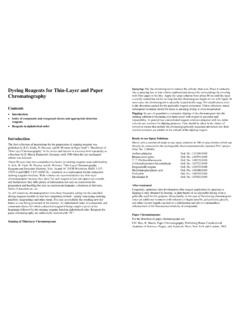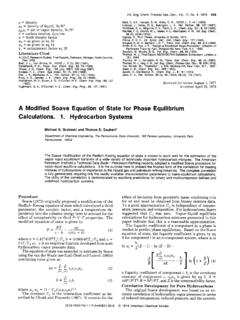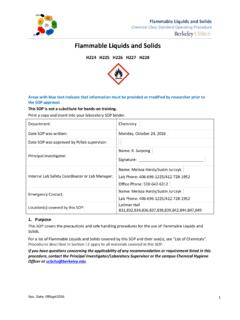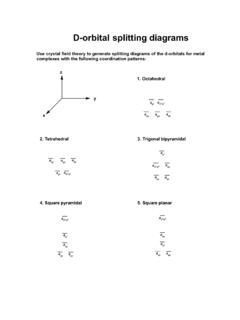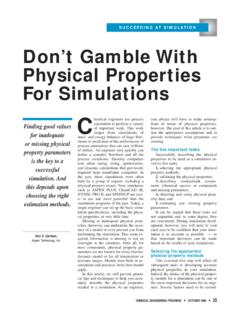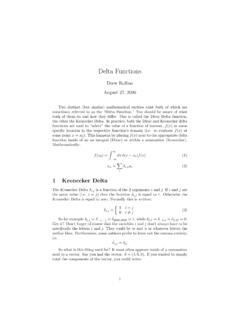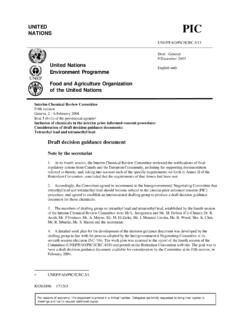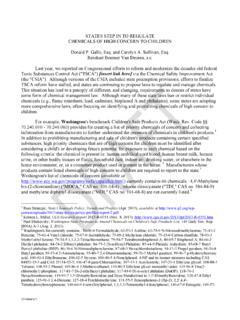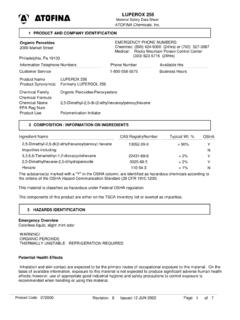Transcription of Water Reactive Materials and Strong Reducing Agents
1 < strong >chemicalstrong > Class Standard Operating Procedures Rev. Date: 14 Apr2014 Page 1 of 23 < strong >Waterstrong > Reactives Class SOP < strong >Waterstrong > < < strong >Strongstrong > >Reactivestrong >Strongstrong > > < < strong >Strongstrong > >Materialsstrong >Strongstrong > > and < strong >Strongstrong > < < strong >Strongstrong > >Reducingstrong >Strongstrong > > < < strong >Strongstrong > >Agentsstrong >Strongstrong > > H260 H261 Examples: lithium, sodium, cesium, lithium aluminum hydride, calcium hydride, potassium hydride Department: Chemistry Date SOP was written: March 23, 2015 Date SOP was approved by PI/lab supervisor: March 25, 2015 Principal Investigator: Name: Richmond Sarpong Signature: _____ Internal Lab Safety Coordinator or Lab Manager: Name: Paul Leger Lab Phone: 510-643-2485 Office Phone: 510-642-6312 Emergency Contact: Name: Richmond Sarpong Phone Number: 626-644-2407 Location(s) covered by this SOP: 834, 836, 837, 838, 839, 842, 844, 847, 849, 907 1. Purpose This SOP covers the precautions and safe handling procedures for the use of < strong >Waterstrong > < < strong >Strongstrong > >Reactivestrong >Strongstrong > > Chemicals, which include the following chemicals and their uses: Note: A * next to < strong >chemicalstrong > indicates that it is also an Acutely Toxic < strong >chemicalstrong > .
2 Note: A ** next to a < strong >chemicalstrong > indicates that it is also a Peroxide Forming < strong >chemicalstrong > . CasNumber Chemical_Name Procedure Exhibit 16940-66-2 sodium borohydride (powder) 2 Exhibit 1 16853-85-3 Lithium aluminum hydride 2 Exhibit 1 7439-93-2 Li Wire 1 Exhibit 1 16940-66-2 sodium borohydride 2 Exhibit 1 7439-93-2 Lithium 1 Exhibit 1 7440-23-5 Sodium 1 Exhibit 1 7440-23-5 sodium in kerosene 1 Exhibit 1 16940-66-2 Sodium borohydride pellets 2 Exhibit 1 7440-23-5 Sodium pieces in mineral oil 1 Exhibit 1 < strong >chemicalstrong > Class Standard Operating Procedures Rev. Date: 14 Apr2014 Page 2 of 23 < strong >Waterstrong > Reactives Class SOP 7440-23-5 sodium metal 1 Exhibit 1 7439-93-2 lithium wire 1 Exhibit 1 7782-92-5 sodium amide** 2 Exhibit 1 77299-63-9 Lithium diisobutyl-tert-butoxyaluminum hydride solution* 4 2428-06-0 2-chloro-5,5-dimethyl-1,3,2-dioxaphospho rinane 3 7782-89-0 Lithium amide 2 5565-32-2 Chlorotris(trimethylsilyl)silane 3 4301-14-8 ethynylmagnesium bromide 4 25015-63-8 4,4, ,3,2-dioxaborolane (1 M in THF) 4 109704-53-2 tetramethylammonium triacetoxyborohydride 2 19172-47-5 2,4-bis(4-methoxyphenyl)
3 -1,3,2,4-dithiadiphosphetane-2,4-disul 3 19172-47-5 Lawesson's Reagent 3 6867-30-7 Lithium acetylide-ethylene diamine complex 2 694-53-1 Phenylsilane 4 67969-82-8 Tetrafluoroboric acid diethyl ether complex 4 75-16-1 Methylmagnesium Bromide Solution 4 75-16-1 Methylmagnesium bromide 3M in ether 4 75-16-1 Methylmagnesium bromide 4 13289-97-9 N,N-diethylaniline borane complex 4 75-77-4 Chlorotrimethylsilane 3 21969-32-4 1-methyl-2-propenylmagnesium chloride, M soln in THF 4 7440-19-9 Samarium powder 2 7440-19-9 Samarium 2 3536-96-7 vinylmagnesium chloride, m in thf 4 37342-97-5 bis(cyclopentadienyl)zirconium chloride hydride 3 37342-97-5 bis(cyclopentadienyl)zirconium hydride 3 37342-97-5 Bis(cyclopentadienyl)zirconium(IV) chloride hydride 3 37342-97-5 Zirconocene Chloride Hydride 3 92390-26-6 CHLORO(1,5-CYCLOOCTADIENE) 4 925-90-6 Ethylmagnesium bromide 4 925-90-6 Ethylmagnesium bromide M 4 107149-56-4 Chlorodiethylisopropylsilane 3 1068-55-9 Isopropylmagnesium chloride solution 4 1068-55-9 isopropylmagnesium chloride 4 1068-55-9 isopropyl magnesium chloride 4 < strong >chemicalstrong > Class Standard Operating Procedures Rev.
4 Date: 14 Apr2014 Page 3 of 23 < strong >Waterstrong > Reactives Class SOP 56553-60-7 Sodium triacetoxyborohydride 2 11110-52-4 sodium mercury amalgam* 2 22722-98-1 Vitride(R) T < < strong >Strongstrong > >Reducingstrong >Strongstrong > > < strong >agentstrong > * 4 22722-98-1 Red-Al* 4 917-65-7 methylaluminum dichloride (1M in hexanes)* 4 280-64-8 solution * 4 88-68-6 Anthranilamide* 2 54575-49-4 Potassium tri-sec-butylborohydride 2 11135-81-2 Potassium-Sodium alloy 1 1826-67-1 Vinylmagensium bromide, solution in THF 4 1826-67-1 Vinylmagnesium Bromide 4 1826-67-1 Vinylmagnesium bromide, solution in THF 4 26134-62-3 Lithium nitride 2 17476-04-9 lithium tri-tert-butoxyaluminohydride 2 7789-78-8 calcium hydride 2 7580-67-8 Lithium hydride 2 7693-26-7 Potassium hydride 2 7439-96-5 Manganese Metal 2 7439-96-5 Manganese 2 693-04-9 butylmagnesium chloride ( in THF) 4 1314-80-3 Diphosphorous pentasulfide 4 4984-82-1 Sodium cyclopentadienide 2 22560-16-3 Super-Hydride M lithium triethylborohydride in THF 4 22560-16-3 Lithium triethylborohydride 2 13292-87-0 Borane-methylsulfide complex 4 13292-87-0 Borane-methyl sulfide complex 4 13291-18-4 Isopropenylmagnesium bromide, M solution in THF 4 15681-89-7 Sodium borodeuteride 2 1066-35-9 N-Cyclohexyl-N-(2-morpholinoethyl)carbod iimide chlorodimethyls 3 1730-25-2 Allylmagnesium bromide M in Diethyl Ether 4 14044-65-6 borane 1M THF 4 14044-65-6 Borane tetrahydrofuran complex solution ( M in THF) 4 14128-54-2 Lithium aluminum deuteride 2 16949-15-8 Lithium borohydride 2 < strong >chemicalstrong > Class Standard Operating Procedures Rev.
5 Date: 14 Apr2014 Page 4 of 23 < strong >Waterstrong > Reactives Class SOP If you have questions concerning the applicability of any recommendation or requirement listed in this procedure, contact the Principal Investigator/Laboratory Supervisor of your laboratory or Environment, Health and Safety (EH&S). 2. < strong >Waterstrong > < < strong >Strongstrong > >Reactivestrong >Strongstrong > > Chemicals Information < strong >Waterstrong > < < strong >Strongstrong > >Reactivestrong >Strongstrong > > < < strong >Strongstrong > >Materialsstrong >Strongstrong > > are chemicals that can react violently with < strong >Waterstrong > to produce a flammable gas and heat. This classification for < strong >Waterstrong > < < strong >Strongstrong > >Reactivestrong >Strongstrong > > follows the definitions of Global Harmonization System (GHS) of Classification and Labeling of Chemicals. The risks associated with a specific < strong >Waterstrong > < < strong >Strongstrong > >Reactivestrong >Strongstrong > > < strong >chemicalstrong > depend on its reactivity and the nature of the gaseous product (flammable, toxic, or both). Prior to working with a < strong >Waterstrong > < < strong >Strongstrong > >Reactivestrong >Strongstrong > > < strong >chemicalstrong > , identify the gas to be formed when exposed to < strong >Waterstrong > , learn the risks associated with this gas, and develop plans to minimize the risks of handling that < strong >materialstrong > .
6 < strong >Waterstrong > can include moisture in the atmosphere, therefore < strong >Waterstrong > < < strong >Strongstrong > >Reactivestrong >Strongstrong > > are usually used under air-free conditions. 3. Potential Hazards/Toxicity < strong >Waterstrong > < < strong >Strongstrong > >Reactivestrong >Strongstrong > > substances are dangerous when wet because they can undergo a < strong >chemicalstrong > reaction with < strong >Waterstrong > . This reaction may release a gas that can be flammable and/or toxic. In addition, the heat generated when < strong >Waterstrong > contacts such < < strong >Strongstrong > >Materialsstrong >Strongstrong > > is often enough to spontaneously combust or explode. When quenching WR < < strong >Strongstrong > >Materialsstrong >Strongstrong > > , the hazards of the mixture, the WR < strong >chemicalstrong > and the solvent, should be considered together and procedures for safe quenching should reflect the hazard properties of both solvent and solute. As defined by the Globally Harmonized System of Classification and Labeling of Chemicals (GHS), WR < < strong >Strongstrong > >Materialsstrong >Strongstrong > > are defined as substances and mixtures which, in contact with < strong >Waterstrong > , emit flammable gases and are designated by one or more of the following H codes: H260 In contact with < strong >Waterstrong > releases flammable gases which may ignite spontaneously H261 In contact with < strong >Waterstrong > releases flammable gases 4.
7 Engineering Controls The following is the set of engineering controls that are required when quenching WR chemicals: Use a clean fume hood, preferably with the sliding sash windows or a glove box. For hoods with a horizontal sliding sash, position the sash all the way down, stand behind the sliding windows and reach around to perform the manipulations required. For hoods with a vertical sliding sash, keep the sash as low as possible. Remove any flammables (squirt bottles, solvents, oil bath) and combustibles (Kimwipes, paper towels) from the area that will be used for the quenching. 5. Personal Protective Equipment At a minimum, the following PPE must be worn at all times. Eye Protection A. ANSI safety glasses with side shields or < strong >chemicalstrong > splash goggles. Ordinary prescription glasses will NOT provide adequate protection unless they also meet ANSI standard and have compliant side shields.
8 B. If the potential for explosion/splashing exists, and adequate coverage is not provided by the hood sash, a face shield should be worn. < strong >chemicalstrong > Class Standard Operating Procedures Rev. Date: 14 Apr2014 Page 5 of 23 < strong >Waterstrong > Reactives Class SOP Skin Protection A. Flame-resistant lab coat (Nomex IIIA, NFPA 2112) should be worn when working with < strong >Waterstrong > - < < strong >Strongstrong > >Reactivestrong >Strongstrong > > < < strong >Strongstrong > >Materialsstrong >Strongstrong > > . B. Gloves are required when handling hazardous < < strong >Strongstrong > >Materialsstrong >Strongstrong > > . Refer to the specific < strong >chemicalstrong > SDS for information on glove selection. C. Long pants, closed-toe/closed-heel shoes, covered legs, and ankles. Cotton-based, non-synthetic clothing should be worn. 6. First Aid Procedures and Medical Emergencies In the event of an injury, notify your supervisor immediately and EH&S within 8 hours. Follow up with a call to 510-642-6060 to report the incident. Go to the Occupational Health Facility (Tang Health Center, on campus); if after hours, go to the nearest emergency room (Alta Bates, 2450 Ashby Ave in Berkeley); or Call 911 (from a cell phone: 510-642-3333) if: it is a life threatening emergency; or you not are confident in your ability to fully assess the conditions of the environment and/or the condition of the contaminated/injured person, or you cannot be assured of your own safety; or the contaminated/injured person is not breathing or is unconscious.
9 Please remember to provide a copy of the appropriate manufacturer SDS (if available) to the emergency responders or physician. At a minimum, be ready to provide the identity/name of any hazardous < < strong >Strongstrong > >Materialsstrong >Strongstrong > > involved. In case of skin contact If skin contact occurs, and/or skin or clothing are on fire, immediately drench in the safety shower with copious amounts of < strong >Waterstrong > for no less than 15 minutes. If possible to do so without further injury, remove any remaining jewelry or clothing. In case of eye contact Rinse thoroughly with plenty of < strong >Waterstrong > using an eyewash station for at least 15 minutes, occasionally lifting the upper and lower eyelids. Remove contact lenses if possible. If swallowed Do NOT induce vomiting unless directed otherwise by the SDS. Never give anything by mouth to an unconscious person. Rinse mouth with < strong >Waterstrong > .
10 Needle stick/puncture exposure Wash the affected area with antiseptic soap and warm < strong >Waterstrong > for 15 minutes. For mucous membrane exposure such as eyes, mouth and/or nose, flush the affected area for 15 minutes using an eyewash station. If inhaled Move into fresh air. 7. Special Handling and Storage Requirements WR chemicals can be handled and stored safely as long as all exposure to moisture or other incompatible chemicals is minimized. Never leave a container with a residue of a WR < strong >materialstrong > open to the atmosphere. < strong >chemicalstrong > Class Standard Operating Procedures Rev. Date: 14 Apr2014 Page 6 of 23 < strong >Waterstrong > Reactives Class SOP Lab-specific information on handling and storage may be included in Section 12 - Protocol/Procedure section. Working Alone The UC Berkeley Office of Environmental Health and Safety specifies not to work with WR chemicals alone or during off hours, when there are few people around to help.
